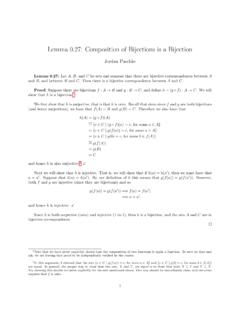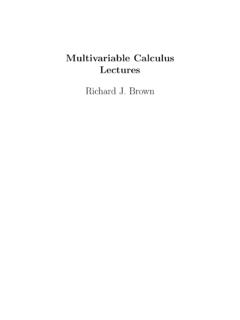Transcription of An Modern Introduction to Dynamical Systems
1 An Modern Introduction toDynamical SystemsRichard J. BrownContentsPrefaceiiiChapter 1. What is a Dynamical system ? Ordinary Differential Equations (ODEs) Symbolic Higher-order The viewpoint12 Chapter 2. Simple A simple The The Contraction Contractions on Contractions in several Application: Newton-Raphson Application: Existence and Uniqueness of ODE Application: Heron of Interval Fixed point Monotonic Homoclinic/heteroclinic First Return A Quadratic Interval Map: The Logistic More general metric The unit The The A Cantor The Koch Sierpinski Gasket:63 Chapter 3. Linear Maps Linear, First-order ODE Systems in the Local Linearization and Equilibria Linear Planar Sinks & Star Degenerate Spirals and The Matrix Application: Competing Species81 The Fixed Points,84 Type and 4.
2 Rotations of the Continued Fraction Application: Periodic Function Reconstruction via Linear Flows on the Application: Lissajous Application: A polygonal Application: The Kepler Toral 5. Conservative Newtonian Systems of Classical Exact Differential Newton s First The Planar Dynamics of elliptic Application: Pitcher Problems140 Chapter 6. Complicated Orbit Counting Periodic The quadratic Expanding Hyperbolic Toral Inverse Limit Symbolic Chaos and Sensitive Dependence on Initial Topological Conjugacy165 Chapter 7. Dynamical Box Quadratic Maps (revisited)177 PrefaceThe following text comprises the content of a course I have designed and havebeen running at Johns Hopkins University since the Spring of 2007. It is a senior(read: 400-level) analysis course in the basic tools, techniques, theory and devel-opment of what is sometimes called the Modern theory of Dynamical Systems .
3 Themodern theory, as best as I can define it, is a focus on the study and structure ofdynamical Systems as little more than the study of the properties of one-parametergroups of transformations on a topological space, and what these transformationssay about the properties of either the space or the group that is acting. It is apure mathematical endeavor in that we study the material simply for the struc-ture inherent in the constructions, and not for any particular application or outsideinfluence. It is understood that many of the topics comprising this theory havenatural, beautiful and important applications, some of which actually dictate theneed for the analysis. But the true motivation for the study is little more than thefact that it is beautiful, rich in nuance and relevance in many tangential areas ofmathematics, and that it is I originally pitched this course to the faculty here at Hopkins, there wasno course like it in our department.
4 We have a well-developed engineering school,filled with exceptionally bright and ambitious students, which along with strongnatural and social science programs provide a ready audience for a course on thepure mathematical study of the theory behind what makes a mathematical modeland why do we study them. We have a sister department here at Homewood,the Applied Mathematics and Statistics Department, which also offers a course indynamical Systems . However, their course seemed to focus on the nature and studyof particular models that arise often in other classes, and then to mine those modelsfor relevant information to better understand them. But as a student of the field,I understood that a course on the very nature of using functions as models andthen studying their properties in terms of the Dynamical information inherent inthem was currently missing from our collective curriculum.
5 Hence the birth of my personal and humble opinion, it continues to be difficult to find a goodtext that satisfies all of the properties I think would constitute the perfect textfor a course such as this one: (1) a focus on the pure mathematical theory of theabstract Dynamical system , (2) advanced enough that the course can utilize therelevant topological, analytical and algebraic nature of the topic without requiringso much prerequisite knowledge as to limit enrollment to just mathematicians, (3)rich enough to develop a good strong story to tell which provides a solid foundationfor later individual study, and (4) basic enough so that students in the naturalsciences and engineering can access the entirety of the content given only the basicfoundational material of vector calculus, linear algebra and differential is a tall order, this is understood. However, it can be accomplished, I believe,and this text is my attempt at original text I chose for the course is the textA First Course in Dynamics,by Boris Hasselblatt and Anatole Katok (Cambridge University Press: 2003).
6 Awonderfully designed story-line from two transformational mathematicians in thefield, I saw the development line they took, from the notion of simple dynamicsto the more complicated, as proper and intuitive. I think their focus on usingthe properties of functions and that of the spaces they are acting upon to developmaterial is the correct one for this Modern approach. And their reuse of particularexamples over and over again as the story progresses is a strong one. However, inthe years I have been teaching and revising the course, I have found myself, addingmaterial, redesigning the focus and the schedule, and building in a slightly differentstoryline. All of this diverging from the text. Encouraged by my students and mygeneral thrill at the field, I decided to create my version of a text. This manuscriptis this the reader will find in this text is my view of the basic foundationalideas that comprise a first (and one semester) course in the Modern theory ofdynamical Systems .
7 It is geared toward the upper-level undergraduate studentstudying either mathematics, or engineering or the natural and social sciences witha strong emphasis in learning the theory the way a mathematician would want toteach the theory. It is a proof-based course. However, when I teach the course, I dounderstand that some of my students do not have experience in writing mathematicsin general and proofs in particular. Hence I use the content of the course as a way toalso introduce these students to the development of ideas instead of just is my hope that these students, upon finishing this course, will begin to look atthe models and analysis they see in their other applied classes with an eye to thenature of the model and not just to its mechanics. They are studying to be scholarsin their chosen field. Their ability to really see the mathematical structure oftheir tools will be necessary for them to contribute to their course (this text) is designed to be accessible to a student who has had agood foundational course in the following: vector calculus, at least up to the topics of surface integration and the big three theorems of Green, Stokes and Gauss; linear algebra, through linear transformations, kernels and images, eigenspaces,orthonormal bases and symmetric matrices.
8 And differential equations, with general first and second order equations, linearsystems theory, nonlinear analysis, existence and uniqueness of first ordersolutions, and the I make it clear in my class that analysis and algebra are not necessaryprerequisites, this course cannot run without a solid knowledge of the convergence ofgeneral sequences in a space, the properties of what makes a set a topological space,and the workings of a group. Hence in the text we introduce these ideas as needed,sometimes through development and sometimes simply through Introduction anduse. I have found that most of these advanced topics are readily used and workablefor students even if they are not fully explored within the confines of a universitycourse. Certainly, having sat through courses in advanced algebra and analysiswill be beneficial, but I believe they are not necessary. The text to follow, likeall proper endeavors in mathematics, should be seen as a work in progress.
9 ThePREFACE vstoryline, similar to that of Hasselblatt and Katok, is to begin with basic definitionsof just what is a Dynamical system . Once the idea of the Dynamical content of afunction or differential equation is established, we take the reader a number oftopics and examples, starting with the notion of simple Dynamical Systems to themore complicated, all the while, developing the language and tools to allow thestudy to continue. Where possible and illustrative, we bring in applications to baseour mathematical study in a more general context, and to provide the reader withexamples of the contributing influence the sciences has had on the general pepper the sections with exercises to broaden the scope of the topic in currentdiscussion, and to extend the theory into areas thought to be of tangential interestto the reader. And we end the text at a place where the course I teach ends, ona notion of Dynamical complexity, topological entropy, which is still a active areaof research.
10 It is my hope that this last topic can serve as a landing on which tobegin a more individualized, higher-level study, allowing the reader to further theirscholarly endeavor now that the basics have been am thankful to the mathematical community for facilitating this work, bothhere at Hopkins and beyond. And I hope that this text contributes to the learningof high-level mathematics by both students of mathematics as well as studentswhose study requires mathematical 1 What is a Dynamical system ? DefinitionsAs a mathematical discipline, the study of Dynamical Systems most likely orig-inated at the end of the 19th century through the work of Henri Poincare in hisstudy of celestial mechanics (footnote this: See Scholarpedia[History of DS]). Oncethe equations describing the movement of the planets around the sun are formu-lated (that is, once the mathematical model is constructed), looking for solutions asa means to describe the planets motion and make predictions of positions in timeis the next step.










